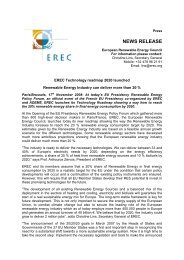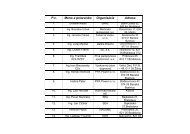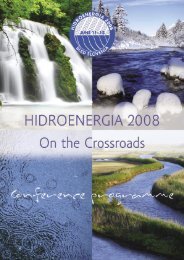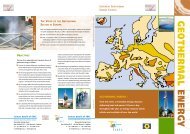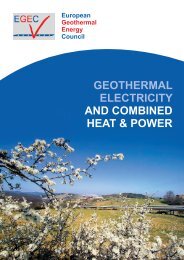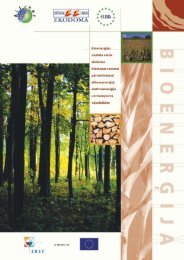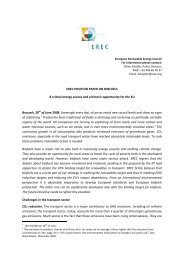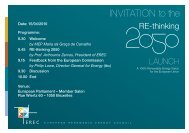English version - European Renewable Energy Council
English version - European Renewable Energy Council
English version - European Renewable Energy Council
Create successful ePaper yourself
Turn your PDF publications into a flip-book with our unique Google optimized e-Paper software.
Conference ProgrammeEUROPEANCONFERENCEFOR RENEWABLE ENERGY‘INTELLIGENT POLICYOPTIONS’BERLIN19-21 JANUARY 2004The Conference is underthe high patronage ofLoyola de PalacioVice-President of the<strong>European</strong> CommissionCommissioner for <strong>Energy</strong> and TransportJürgen TrittinFederal Minister for EnvironmentNature Conservation and Nuclear Safety<strong>European</strong> CommissionDirectorate General for <strong>Energy</strong> and TransportRENEWABLE ENERGY FOR EUROPECampaign for Take-Off
C O N F E R E N C E P R O G R A M M ECONFERENCE PROGRAMME OVERVIEWMonday 19 January 2004C O N F E R E N C E P R O G R A M M E O V E R V I E W2IntroductionSession 1:14.00 - 18.00The Campaign forTake-Off 1999-2003:Sharing skills andachievements to foster<strong>Renewable</strong> <strong>Energy</strong>developmentin EuropeTuesday 20 January 2004Session 2:09.00 - 18.00Implementation of<strong>Renewable</strong> <strong>Energy</strong>Sources Policies inthe <strong>European</strong> MarketsWednesday 21 January 2004Session 3:09.00 - 12.30Looking forward:Horizon 202009.00 - 10.00 Registration10.00 - 11.30 Official opening of the conference11.30 - 12.30 <strong>Renewable</strong> <strong>Energy</strong> Sources: Policy frameworkand progress in the EU up to now12.30 - 14.00 Lunch14.00 - 15.00 Panel 1a: Experiences in the utilisation of <strong>Renewable</strong> <strong>Energy</strong> Sourcesin cities - How feasible is it to develop <strong>Renewable</strong> <strong>Energy</strong> generationin an urban environment?15.00 - 16.00 Panel 1b: <strong>Renewable</strong> <strong>Energy</strong> Sources deployment at regionaland local level - From dependency to security of supply:How far and fast can regions improve their energy mix?16.00 - 16.30 Coffee break16.30 - 17.30 Panel 1c: Paving the way towards 100 % <strong>Renewable</strong> <strong>Energy</strong>based communities & islands: utopia or ambitious reality?17.30 - 18.00 Conclusions and recommendations for the future actionin Europe and at Community level19.00 The 2003 Awards Ceremonyof the <strong>Renewable</strong> <strong>Energy</strong> Campaign for Take-Off09:00 - 10.30 Panel 2a: Producing <strong>Renewable</strong> Electricity - What is being achievedand what are the best approaches for overcoming administrativeand market barriers?10.30 - 11.00 Coffee break11.00 - 12.30 Panel 2b: Supporting <strong>Renewable</strong>s Electricity in the Market - Whichare the best support schemes for RES electricity applied in Europe?12.30 - 14.00 Lunch14.00 - 14.30 Biofuels for the transport sector: the real start in Europe now?14.30 - 16.00 Panel 2c: <strong>Renewable</strong> Heating & Cooling - What are the common factorsand barriers which influence the growth of <strong>European</strong> markets forsolar, biomass and geothermal heating and cooling?16.00 - 16.30 Coffee break16.30 - 18.00 Panel 2d: <strong>Renewable</strong> <strong>Energy</strong> – How to create a level-playing field?20.00 Reception by the German Ministry for the Environment,Nature Conservation and Nuclear Safety09.00 - 10.30 Panel 3a: Targets and Scenarios for the development of <strong>Renewable</strong><strong>Energy</strong> Markets in Europe up to 202010.30 - 11.00 Coffee break11.00 - 12.30 Panel 3b: From Rio to Kyoto and JohannesburgThe spotlight has turned towards <strong>Renewable</strong> <strong>Energy</strong> Sources.12.30 - 13.30 Conference closure - Conclusions and recommendations for theInternational Conference for <strong>Renewable</strong> <strong>Energy</strong> in June 2004 in Bonn
C O N F E R E N C E P R O G R A M M EMonday, 19 th January 2004CONFERENCE OPENING• Klaus Wowereit, Mayor of Berlin• Mechtild Rothe, Member of the <strong>European</strong> Parliament,President of EUFORES• Jürgen Trittin, Federal Minister for Environment,Nature Conservation and Nuclear Safety of Germany• Loyola de Palacio, Vice-President of the <strong>European</strong>Commission, Commissioner for <strong>Energy</strong> and TransportRENEWABLE ENERGY SOURCES:POLICY FRAMEWORK AND PROGRESS IN THE EU UP TO NOW• Günther Hanreich, Director, <strong>European</strong> Commission, DG <strong>Energy</strong> & Transport• Arthouros Zervos, President, ERECSession 1: The Campaign for Take-Off 1999-2003PANEL 1A: RES IN CITIESModerators: Soeren Moeller, Deputy Mayor of Odense, President,Energie-Cités - Mariàngels Pérez Latorre, Deputy Head of Unit,<strong>European</strong> Commission, DG <strong>Energy</strong> & TransportPanellists: Imma Mayol, Vice-Mayor, Barcelona - Bo Frank, Vice-Mayor, Växjö - Serge Godard, Mayor, Clermont-Ferrand - JoachimLorenz, Member of the City <strong>Council</strong>, Munich - Zsolt Fábián, Head ofthe Economic Committee, GödöllöPANEL 1B: RES DEPLOYMENT AT REGIONAL AND LOCAL LEVELModerators: Michael Geissler, Secretary General, FEDARENE -Dominique Bidou, Président, Association pour la Haute QualitéEnvironnementalePanellists: Gerhard Dell, <strong>Energy</strong> Commissioner, Upper Austria -José Javier Armendariz, Regional Minister for Industry, Technology,Commerce and Labour, Navarra - Tagh O’Donovan, Mayor of CorkCounty - Jean-Loup Fleuret, Vice-President of the Regional <strong>Council</strong>,Rhône-Alpes - Antonio di Nunzio, President of <strong>Energy</strong> and EnvironmentCommission, Province of ChietiPANEL 1C: 100 % RES COMMUNITIES & ISLANDSModerators: Cipriano Marin, Vice Secretary General, INSULA -Melim Mendes, Regional Agency for <strong>Energy</strong> and Environment of theAutonomous Region of MadeiraPanellists: Soeren Hermansen, Manager, <strong>Energy</strong> and Environmentaloffice, Island of Samsoe - Javier Morales Febles, Minister CanaryIsland Government - Mick Bates, Member of the Welsh NationalAssembly - Olympia Stilianou, Director, Ministry of Commerce,Industry and Tourism of Cyprus - Dieter Aschbrenner, Head of theDistrict Authority, Lüchow-DannenbergTuesday, 20th January 2004Session 2: Implementation of RES Policies in EuropePANEL 2A: RES ELECTRICITY - OVERCOMINGADMINISTRATIVE & MARKET BARRIERSModerators: Rainer Hinrichs-Rahlwes, Director General, FederalMinistry for Environment of Germany - Luc Werring, Head of Unit,<strong>European</strong> Commission, DG <strong>Energy</strong> & TransportPanellists: Matthias Eichelbrönner, Managing Director <strong>Renewable</strong>Energies, MVV Energie AG - Joan Fages, President, EREF - Antonio Sàda Costa, ESHA - Annemarie Goedmakers, Director <strong>Renewable</strong>Electricity, NUON - Eddie O’Connor, CEO, AirtricityPANEL 2B: SUPPORTING RES ELECTRICITYModerators: Hermann Scheer, President of EUROSOLAR, Memberof the German Parliament - Roberto Vigotti, ENEL Green Power /Chairman of the Eurelectric working group on R&DGPanellists: Johannes Lackmann, President, German <strong>Renewable</strong><strong>Energy</strong> Association (BEE) - Ernesto Macias, President, EPIA - PeterNiermeier, General Secretary, <strong>Renewable</strong> <strong>Energy</strong> Certificate System- Iain Todd, Director, Department of Trade and Industry - Poul ErikMorthorst, Senior Scientist, Risoe National LaboratoryBIOFUELSHans-Josef Fell, Member of the German ParliamentJavier Salgado, CEO, Abengoa BioenergíaPANEL 2C: RES HEATING & COOLINGModerators: David Taylor, CEO, Sustainable <strong>Energy</strong> Ireland - KarlKellner, Head of Unit, <strong>European</strong> Commission, DG <strong>Energy</strong> & TransportPanellists: Ole Pilgaard, President, ESTIF - Christian Boissavy,President, EGEC - Heinz Kopetz, Vice-President, AEBIOM - RadanPanacek, Deputy Director, Technology Centre of Czech Republic -Markus Kurdziel, Head of Section, German <strong>Energy</strong> Agency (DENA)PANEL 2D: HOW TO CREATE A LEVEL-PLAYING FIELD ?Moderators: Juan Fraga, General Secretary, EUFORES - William Gillett,Deputy Head of Unit, <strong>European</strong> Commission, DG <strong>Energy</strong> & TransportPanellists: Claude Turmes, Member of the <strong>European</strong> Parliament -Nigel Hall, Deputy Head of Division, <strong>European</strong> Investment Bank -Shimon Awerbuch, University of Sussex - Klaus Rave, VicePresident, EWEA - Olaf Hohmeyer, University of FlensburgWednesday, 21st January 2004Session 3: Looking forward: horizon 2020PANEL 3A: TARGETS AND SCENARIOS UP TO 2020Moderators: Anders Wijkman, Member of the <strong>European</strong> Parliament- Corrado Clini, Director General, Ministry for Environment of ItalyPanellists: Eberhard Jochem, Fraunhofer Institute ISI- Fatih Birol, Headof Economic Analysis Division, IEA - Didier Mayer, President, EURECAgency - Jennifer Morgan, Director Climate Change Programme, WWFPANEL 3B: FROM RIO TO KYOTO AND JOHANNESBURGModerators: Klaus Töpfer, Executive Director, UNEP - Jos Delbeke,Director, <strong>European</strong> Commission, DG EnvironmentPanellists: Steve Sawyer, Climate Policy Advisor, GreenpeaceInternational - Elfriede A. More, Austrian Federal Ministry ofAgriculture, Forestry, Environment and Water Management -Rajendra K. Pachauri, Chairman of Intergovernmental Panel onClimate Change / Director-General TERI - Antonio GarcíaFragio, Head of Unit, <strong>European</strong> Commission, DG DevelopmentCONFERENCE CLOSURE• Jorgen Henningsen, Principal Adviser, <strong>European</strong>Commission, DG <strong>Energy</strong> & Transport• Eryl McNally, Member of the <strong>European</strong> Parliament• Heidemarie Wieczorek-Zeul, Federal Minister for Economicco-operation and Development of Germany• A Representative of the Irish Presidency• Margot Wallström, Commissioner for Environment3C O N F E R E N C E P R O G R A M M E O V E R V I E W
C O N F E R E N C E P R O G R A M M EI N T R O D U C T I O NEUROPEAN CONFERENCE FOR RENEWABLEENERGY “INTELLIGENT POLICY OPTIONS”WELCOMESETTING THE CONTEXTEurope is at the forefront of renewable energy developmentworld-wide and has significant experience in theformulation of proactive policy measures in this area.<strong>Renewable</strong> <strong>Energy</strong> Sources make a major contributionto sustainable development and - through using locallyavailable resources - to security of energy supply.<strong>Renewable</strong> <strong>Energy</strong> deployment is part of the solution tomany economic and environmental problems by contributingto secure jobs and income, avoiding environmentaldamage and therefore providing for a validmeans to fight against climate change. From the marketpoint of view, the <strong>European</strong> renewable energy industryhas a lead position in the world and is one of Europe’sfastest growing sectors.The Community and its Member States have laid downclear objectives for renewable energy by 2010 - a shareof 12% of renewable energy in gross inland energy consumption,a share of 22% for green electricity and ashare of 5.75% for biofuels. Legislation has been adoptedin order to reach these objectives. Soon the enlargedUnion will be a reality and a common <strong>Renewable</strong> <strong>Energy</strong>policy framework and objectives will be shared by 25<strong>European</strong> countries while other <strong>European</strong> countries arealso committed in a similar process. Further, addingforce to the international commitment, the <strong>European</strong>Union is at the heart of the Johannesburg <strong>Renewable</strong><strong>Energy</strong> Coalition, grouping industrialised and developingcountries which are determined to work together onthe basis of clear, ambitious and time bound targets tosubstantially increase the global share of renewableenergy sources.AIMS OF THE CONFERENCEBuilding on previous efforts and achievements, and inorder to realise the mid-term targets, further analysisand concerted efforts on political, legislative, administrative,social, cultural, economic and marketing aspectsare required in order to achieve a sound long-term developmentof renewable energy sources.THE EUROPEAN CONFERENCE FOR RENEWABLE ENERGY‘INTELLIGENT POLICY OPTIONS’ pursues a two-foldobjective: Firstly, it will analyse the developments madeto date presenting market evolution and sectoral progresswhilst offering a showcase for lighthouse initiatives fromthe <strong>European</strong> Union’s Campaign for Take-Off for<strong>Renewable</strong> Energies (1999-2003). Secondly, it will providea discussion forum for market prospects, reinforcedpolicies and new renewable energy targetstowards a time horizon of 2020. The debate will concludewith concrete targets and proposals for initiativesaimed at increasing the uptake of renewable energies inan enlarged Union and beyond.4Pictures credits: Diester bus in Vierzon (France) © ADEME Olivier Sébart • Vestas Park in Mahaldas(Spain) © EWEA-Wolf Winters • 2800 m 2 systems for space heating and domestic hot water (Holland)©ATAG Verwarming, Holland • PV modules in Germany © Bundesverband Solarindustrie • Small HydroPower in Austria © Österreichischer Verein für Kleinkraftwerke • Island - Geysir Haetta © Oliver Joswig
C O N F E R E N C E P R O G R A M M EWorking towards the INTERNATIONAL CONFERENCEFOR RENEWABLE ENERGY IN JUNE 2004 IN BONN, theconference will tackle renewable energy strategies forEurope in a larger sense encompassing the Union, itsAccession and Candidate Countries, Norway, Iceland,Liechtenstein, Switzerland and the Western Balkans,and is part of the Johannesburg <strong>Renewable</strong> <strong>Energy</strong>Coalition roadmap of regional initiatives. The conclusionsof the debate will be delivered, together with thosefrom regional conferences in Africa, Asia and LatinAmerica, to the Bonn Conference.PARTICIPANTSThe conference will bring together many key playersfrom the public and private sector at national and internationallevel, including representatives of <strong>European</strong>institutions, international, national, regional and localorganisations, networks and associations, experts anddecision makers from the energy industry, non-governmentalorganisations, consultants, project developers,universities and other research institutions, financinginstitutions as well as local, regional, national and internationaladministrations.STRUCTURE OF THE CONFERENCEThe Conference will open with the addresses of thePatrons, Loyola de Palacio, Vice-President of the <strong>European</strong>Commission, Commissioner for <strong>Energy</strong> and Transportand Jürgen Trittin, Federal Minister for Environment,Nature Conservation and Nuclear Safety. In addition, anumber of leading personalities will outline the mainchallenges to <strong>Renewable</strong> <strong>Energy</strong> policy implementationand progress up to now, and will prepare the ground forthe conference debates.Session 1 will review the Campaign for Take-Off for<strong>Renewable</strong> <strong>Energy</strong> (1999-2003), including challengesand driving forces and offer a showcase for key initiativesin cities, regions and islands in Europe in order to helpother communities on their way towards developing theirunexplored renewable energy potential.Session 2 will focus on the different policies and legislationrelated to <strong>Renewable</strong> <strong>Energy</strong> in the Union and other<strong>European</strong> countries, focusing on three main fields: electricity,heating and cooling, and biofuels. Questions willbe raised and answers will be given to topics such asbarriers to market penetration, competitive pricing,financing and support schemes.Session 3 will build upon the previous days’ debates andcome up with recommendations and targets for Europe for2020. Once agreed, these will become Europe’s contributionto the Johannesburg <strong>Renewable</strong> <strong>Energy</strong> Coalition andwill be conveyed to the International <strong>Renewable</strong> <strong>Energy</strong>Conference in Bonn.The debate on each theme will be led by two moderatorswho should ensure that the discussion (involving panellistsand participants) as well as the outcome are bothproductive and well-balanced.THE CONFERENCE ON LINEThe Conference will be transmitted live on the Internet,through the <strong>European</strong> Commission Managenergy webstreaming services, which are devoted to the promotionof energy efficiency and renewable energy sources. Fullvideo recordings will be made available on the Internetafter the Conference. For one year, the Conference presentationsand discussions as well as interviews withthe honourable guests and main speakers will be availableon www.managenergy.net.SESSIONS WILL THEN BE HELDON THE FOLLOWING THEMES:The Campaign for Take-Off: Sharingskills and achievements to fosterthe development of <strong>Renewable</strong> <strong>Energy</strong>Sources in EuropeImplementation of Policies for <strong>Renewable</strong><strong>Energy</strong> Sources in <strong>European</strong> MarketsLooking forward: Horizon 2020INFORMATION SPACEInformation on Community programmes and stakeholderswill be available during the conference. The <strong>European</strong>Commission, the <strong>European</strong> <strong>Renewable</strong> <strong>Energy</strong><strong>Council</strong> (EREC) and its member associations, organisationsand networks operating in the field of renewableenergy as well as Partners in the Campaign for Take-Offinvite the conference participants to discover theirorganisations, programmes and initiatives at theentrance area of the Conference room in the BerlinConference Centre.I N T R O D U C T I O N5
C O N F E R E N C E P R O G R A M M EMONDAY, 19TH JANUARY 2004COMMUNITY SUPPORT PROGRAMMESM O N D A Y , 1 9 T H J A N U A R Y 2 0 0 4 - P O L I C Y F R A M E W O R K A N D P R O G R E S S<strong>Renewable</strong> <strong>Energy</strong> Sources:Policy framework and progressin the <strong>European</strong> Union up to nowThe <strong>European</strong> Commission has deployed since 1993 substantialefforts to build up a common, stable policy frameworkin Europe to foster the market penetration of<strong>Renewable</strong> <strong>Energy</strong> Sources. Early in the nineties it becameclear that, in addition to the efforts made for more thanthirty years to develop <strong>Renewable</strong> Technologies throughCommunity Research, Demonstration and Innovation programmes,a Policy framework which combines legislativeand support measures was necessary to increase and foster<strong>Renewable</strong> market penetration.6COMMUNITY POLICY FRAMEWORK ANDLEGISLATION: THE MAIN MILESTONESRES in the EU-151997 - White Paper: <strong>Energy</strong> for the future:<strong>Renewable</strong> sources of energy2000 - Green Paper: Towards a <strong>European</strong>strategy for the security of energy supply2001 - Directive on the promotion of electricityproduced from renewable energysources in the internal electricity market2002 - Directive on the energyperformance of buildings2003 - Directive on the promotion ofthe use of biofuels or other renewablefuels for transport2003 - Directive restructuring the communityframework for the taxation of energyproducts and electricityRTD framework programmessince the early 1970’sSAVE programme1992-2002 > 100 M€ALTENER programme1993-2002 > 120 M€Intelligent <strong>Energy</strong> - Europe programme2003-2006 > 250 M€(Continues the actions under SAVEand ALTENER)The Community Policy framework establishes indicativemid-term targets for 2010 both at global and sectorallevel. The first time that the Community proposed a targetfor <strong>Renewable</strong> <strong>Energy</strong> was in the ALTENER programmein 1993: the objective was to double the part of<strong>Renewable</strong> <strong>Energy</strong> in the gross domestic consumptionfrom 4% in 1991 to 8% by 2005. In the White Paper of 1997the objective was to achieve a share of 12% of total EUenergy consumption by 2010. This objective was confirmedin 2000 in the Green Paper on the security of energysupply. Community support programmes have beenoriented to help to reach this objective by promoting EUwidemeasures and actions in favour of <strong>Renewable</strong><strong>Energy</strong> at national, regional and local level.By 2003, the main pillars of the legislative frameworkthat will allow <strong>Renewable</strong> progress in the market hadbeen established. The general objective is now supportedby two Directives which contain sectoral andnational objectives, one for electricity generated from<strong>Renewable</strong> <strong>Energy</strong> in the internal market, and the secondfor biofuels.TYPE 1995 2001 WHITE PAPEROF ENERGY EUROSTAT EUROSTAT PROJECTIONS 20101. Wind 2.5 GW 17.2 GW 40 GW2. Hydro 92 GW 91.7 GW 105 GW3. Photovoltaic 0.03 GWp 0.26 GWp 3 GWp4. Biomass 44.8 Mtoe 56 Mtoe 135 Mtoe5. Geothermal 2.5 Mtoe 3.43 Mtoe 5.2 Mtoe6. Solar Thermal Collectors 6.5 Mio m 2 11.4 Mio m 2 100 Mio m 2Source : Eurostat, 2003
C O N F E R E N C E P R O G R A M M ES E S S I O N 1 - T H E C A M P A I G N F O R T A K E - O F F 1 9 9 9 - 2 0 0 3Session 1THE CAMPAIGN FOR TAKE-OFF 1999-2003SHARING SKILLS AND ACHIEVEMENTS TO FOSTERRENEWABLE ENERGY DEVELOPMENT IN EUROPEThe <strong>European</strong> Commission adopted in November 2000 theGreen Paper ‘Towards a <strong>European</strong> Strategy for the Securityof <strong>Energy</strong> Supply’ and in December 1997 a White Paper‘<strong>Energy</strong> for the Future: <strong>Renewable</strong> Sources of <strong>Energy</strong>’.From this background, the <strong>European</strong> Community intends tofoster the market penetration of renewable energies byimplementing regulatory measures and Community supportand promotional programmes. A key initiative amongstthe promotional measures is the Campaign for Take-Off(CTO) for <strong>Renewable</strong> Energies. Created in 1999 and runningthrough until the end of 2003, it was designed to support thestrategy for renewable energy as a whole.Its aims were to provide quantitative targets for each of the8 renewable energy sectors covered by the Campaign, toserve as benchmarks for decision makers and planners, todisseminate successful initiatives in Europe, to spreadbest-practice and to raise critical awareness of decisionmakers at local, regional, national and <strong>European</strong> level. Anumber of initiatives feeding into the Campaign’s objectiveswere born out of this initiative under other relevantCommunity Support Programmes such as the ALTENERand 5 th /6 th RTD Framework Programmes.The Campaign also provided for a number of promotionaltools coordinated at <strong>European</strong> level such as the CTOConferences, the successful <strong>Renewable</strong> <strong>Energy</strong> PartnershipScheme and the prestigious annual CTO AwardCompetition. These were created to reward the efforts andcommitments made at local, regional and national level aswell as to expose these efforts as showcases for the generalpublic in Europe and beyond.The Conference will serve to take stock of the Campaign forTake-Off in its different areas, provide a discussion forum onits pertinence and, finally, will set the direction and conveymessages for a successor initiative at the <strong>European</strong> level.The debates will be complemented with the results of anImpact Assessment conducted during the last year of theCampaign, which will be made available to the participantsas a reference document, and this will be enriched with thesession’s conclusions. From this starting point, the specificpanels will present key success factors and ways to overcomebarriers for initiatives pushed forward in cities, regionsand islands. They will explore the driving forces behind the8initiatives, the challenges encountered, the replication potentialand the relevance of policy frameworks. The successfullyimplemented examples should help other communities byshowing the best ways of using the existing renewable energypotential, thereby not only contributing to local economicdevelopment and to the creation of jobs but also to environmentprotection and to social welfare. Finally, the conferencewill pave the way for the launching of an extended and broadersuccessor initiative by the <strong>European</strong> Commission, the‘Campaign for an <strong>Energy</strong> Sustainable Europe, 2004-2007’.THE FUTURE CAMPAIGN (2004-2007)The <strong>Renewable</strong> <strong>Energy</strong> Campaign for Take-Offwill evolve and pave the way for a new Campaign,the ‘Public Awareness Campaign for an <strong>Energy</strong>Sustainable Europe’. Starting in 2004, the newcampaign will embrace both energy efficiencyand renewable energies and will allow Partnersto join the common effort of implementing programmesand initiatives in Europe and beyond.Today’s <strong>Renewable</strong> <strong>Energy</strong> Partners will naturallybecome Partners in the new Campaign.WHO ARE THE RENEWABLE ENERGY PARTNERS125 renewable energy programmes and projectsinvolving more than 700 partner organisations inthe <strong>European</strong> Union – municipalities, agencies,technological institutes, regional authorities,national institutions, universities and enterprises- have joined the Campaign as <strong>Renewable</strong><strong>Energy</strong> Partners in 2000-2003 and therebyexpressed openly their willingness to contributeto its objectives. Organisations and authoritiesfrom the Accession Countries joined theCampaign at an early stage with successful initiativesat local level or through joint initiativeswith other <strong>European</strong> Union organisations.<strong>Renewable</strong> <strong>Energy</strong> Partnerships in figures 2000-2003■ 100% Communities (28%)■ Regional (25%)■ Promotion (16%)■ National (13%)■ Industry (10%)■ Local Communities (5%)■ Developing Countries (3%)3%5%28%10%13%25%16%Source : <strong>European</strong> Commission, 2003
C O N F E R E N C E P R O G R A M M EPanel 1a:EXPERIENCES IN THE UTILISATION OF RENEWABLEENERGY SOURCES IN CITIES - HOW FEASIBLE ISIT TO DEVELOP THE POTENTIAL OF RENEWABLE ENERGYGENERATION IN AN URBAN ENVIRONMENT?Nearly 80% of the <strong>European</strong> population live, work anduse leisure facilities in cities, almost the half in citieswith more than 50.000 inhabitants. Nearly 70% of theenergy consumption occurs in cities. The developmentof sustainable energy strategies in urban areas is clearlya priority. It is not only the large numbers of energyconsumers which is at stake, but also the quality of theurban environment which is of fundamental concern,and for which the implications go far beyond the localcommunity. Apart from environmental considerations, alocal sustainable energy policy can have major impactson employment, social cohesion, participation of civilsociety, and economic development, as well as on urbangovernance. Examples have shown that proactive RESpolicies in cities can substantially increase the share ofRES, thereby improving living conditions and contributingto reaching the objectives outlined by the UnitedNations in their AGENDA 21 initiative.More recently, there have been clear signs of a politicalcommitment towards more integrated policies and conceptsaiming to convey sustainable energy strategies intocity policies. Such commitments aim at demonstratingthe benefits of a high degree of decentralised energysupply through recourse to new and renewable energysources, in combination with a conscious application ofleading energy efficiency measures in the various endusesectors. Recent <strong>European</strong> legislation in the energyfield, such as the Directive on the <strong>Energy</strong> Performance ofBuildings, pushes forward this integrated approach, andshould open the opportunity for more efficient consumptionthrough ambitious urban rehabilitation.How does the use of <strong>Renewable</strong> <strong>Energy</strong> Sourcesin cities lead to better standards of living anda reduced environmental impact?How relevant are policy frameworks to increased<strong>Renewable</strong> <strong>Energy</strong> penetration in urban areas?How to tackle the challenge of integratedconcepts “high energy-efficiency / decentralisedRES” in urban energy planning?Several large urban areas across Europe have demonstratedan outstanding level of excellence with regard tothe integration of sustainable energy concepts, includingrenewable energies. In the North or in the South ofEurope, numerous examples illustrate how far awarenessof and commitment to renewable energy solutionscan make cities improve in their energy planning andresource management. Politicians, planners, developersand citizens are all key stakeholders in this process, andcan help to achieve a genuine change in the urban energyscene. This session will present examples of successfulrealisations of sustainable strategies, discuss barriersand challenges, assess the impact of policy frameworksand come up with future needs for public interventionon the level of municipal authorities, MemberStates frameworks and <strong>European</strong> intervention.Cities2500200015001000The Aalborg Charter, the Charter of <strong>European</strong>Cities and Towns towards Sustainability is a uniquepolicy statement for local sustainable developmentworld-wide. Born in 1994 and initially signed by 80local authorities, it counts today more than 2000signatories - metropolitan areas, cities, towns andcounties. The Charter itself provides for a policyframework initiating processes to the creation ofsustainable development plans at local level, initiatedthe <strong>European</strong> Sustainable Cities & TownsCampaign to support cities on their path towardssustainability and calls upon the local authorities toengage in the Local Agenda 21 Processes.Signatories of the Aalborg Charter 1994 - 2003500080174305383446What recommendations and hints for successcan be derived from existing initiatives?What sort of Community intervention andpromotion would be appropriate for the next5 years in the form of a future “<strong>European</strong>Public Awareness Campaign?”62788014061859What should be the role of the privatesector in this context during next 5 years?20301994 1995 1996 1997 1998 1999 2000 2001 2002 2003Source : <strong>European</strong> Sustainable Cities & Towns CampaignR E S I N C I T I E S - P A N E L 1 a9
C O N F E R E N C E P R O G R A M M EP A N E L 1 b - R E S A T R E G I O N A L A N D L O C A L L E V E LPanel 1b:RENEWABLE ENERGY SOURCES DEPLOYMENTAT REGIONAL AND LOCAL LEVEL - FROM DEPENDENCYTO SECURITY OF SUPPLY: HOW FAR AND FAST CANREGIONS IMPROVE THEIR ENERGY MIX?Europe’s regions and their local communities are closestto the final energy consumer. When it comes to renewableenergy sources, the work of regional authorities andmunicipalities is therefore of outstanding importance.Due to their decentralised nature, many renewable energytechnologies are closer to the end consumer than conventionalenergy technologies and can therefore be particularlywell promoted on both regional and local levels.Furthermore, they represent an excellent opportunity forwealth creation in urban and remote areas through thecreation of jobs and income for the local population.In order to further promote renewable energy sourcesand demand management, integrated energy planningat local and regional level, incorporating a mix of legal,regulatory, financial, communication and trainingmeasures are necessary. Many regions in Europealready apply such an integrated approach which contributesto increasing the security of supply and minimizesthe external energy dependence. This is especiallyrelevant in times of liberalization of energy markets,where the decentralized approach is gaining in importance.An increasing number of representative casesare emerging in Europe, leading to substantially highRES shares, even designed to reach 100% of local energysupply and, resulting from this, to the stimulation ofthe local/regional economy, while improving the environment.Cross-border cooperation between regions ofdifferent countries of the <strong>European</strong> Union and itsAccession States has brought forward fruitful synergyeffects, promoting best-practice and sharing lessonslearnedtowards a common objective.In recent years, the <strong>European</strong> Commission has beenplacing an increased emphasis on capacity building atregional and local level, through the creation of regionaland local energy agencies. The first agencies dateback to the late 1980s and early 1990s. Nowadays, theCommission is working with around 250 local andregional energy agencies spread all over Europe, withthe objective of developing and implementing a combinedenergy efficiency and renewable energy strategyfor their respective fields of activity.10This session will illustrate the importance of actions atregional and local level for the development of renewableenergy sources. It will give an overview of the key lessonslearnt on the basis of examples collected from all overEurope. It will also address challenges, barriers and waysforward and, finally, it will discuss the impact of existingpolicy frameworks and put forward suggestions for futureaction at Community level.How does a high share of <strong>Renewable</strong> <strong>Energy</strong>Sources at regional and local level contributeto job creation and economic growth?<strong>Renewable</strong> <strong>Energy</strong> is an alternative economicactivity in rural areas whose development islagging behind and in declining industrialareas – what are the reasons for success?Which <strong>Renewable</strong> <strong>Energy</strong> technologies aremost successful in these areas and whichtechnologies are unexpectedly left behind?What are the main barriers / stimulating factorsfor RES development at regional and local level?What recommendations and hints for successcan be derived from existing initiatives?What sort of Community intervention andpromotion would be appropriate duringthe next 5 years as the basis for a future“<strong>European</strong> Public Awareness Campaign?”REGIONAL ENERGY PLANSTHE CASE OF NAVARRA (SPAIN)The region of Navarra is located on the westernmost partof the Pyrenees, on the border with France. It has a populationof 550,000 inhabitants, and is counted among thepioneers of Europe in wind energy development. TheNavarra <strong>Energy</strong> Plan (1995-2000) paved the way to supplying40% of the region’s electricity needs in 2000 from windenergy –nearly double the original target. In 2002, installedrenewable energy capacity produced 55% of the electricityconsumed. This boost was achieved by the clear objectivesof the regional <strong>Energy</strong> Plan, broad social acceptance ofwind energy facilities, and private promoters.The Navarra <strong>Energy</strong> Plan Targets for 2005 foresees yetagain a doubling of RES electricity capacity, includingthe doubling of wind installed capacity and expansion insolar photovoltaic and solar thermal generation – aimingtowards a 97% green electricity coverage by 2005.
C O N F E R E N C E P R O G R A M M EPanel 1c:PAVING THE WAY TOWARDS 100 % RE BASED COMMU-NITIES & ISLANDS: UTOPIA OR AMBITIOUS REALITY?Modern societies are seeking to implement integrateddevelopment models and infrastructure that will accommodatesocial and economic requirements and expectations,respect the environment and that will be sustainable.The integration of all these, sometimes conflicting, elementsis a complex issue and calls for the guidance providedby successful examples of a manageable size, and thatcan point the way forward for larger units. Local energycommunities can pioneer the application of the integratedmeasures which are required to attain our global commitmentsand, as a result, become excellence-models for thedissemination of such concepts around Europe. An increasingnumber of communities in Europe are committed toreach renewable energy shares which go far beyond the EUglobal objectives: they do not speak of 12% RES share, butare working to achieve 100% <strong>Renewable</strong> <strong>Energy</strong> supply.Islands and isolated rural communities, particularly in theremote or outermost regions of Europe are at present highlychallenging laboratories for the development of 100% RESsolutions, due to their scale, highly costly or lack of conventionalresources, abundance of renewable resources, needof future energy reliability and the environmental and economicimpacts caused by importing conventional energy.Communities and islands aiming towards 100% RES aretoday facing the double challenge of firstly having to consolidatetheir recently attained achievements, and secondly todemonstrate that they have the capacity to contribute to thelarge-scale deployment of renewables at a <strong>European</strong> level.In Europe some pioneer Communities have shown theway and through the Campaign for Take-Off, a number ofpilot communities - regions, cities and islands, which aimat 100% renewable energy supply, have become Partnerswith the <strong>European</strong> Commission. These should serve ascredible pacemakers showing to other communities theright way to achieve large-scale development of 100% RESprojects. Their initiatives and strategies represent in manyrespects the most successful future energy policies basedon renewables. They serve as essential references in thesearch for solutions to the complex problems and challengesbrought by technological innovation, favourablemarkets, appropriate regulations and social participationand facilitate the consolidation of renewables-based scenarios.This session will present the policies and experiencesof rural and island communities in the EU from awide range of different perspectives, and the discussionswill focus on those aspects which could form the basis forfuture actions aimed at building on their successes. Theaim will be to explore how best to use the existing actionsand experiences in the future, and if necessary to adaptthem in order to make them attractive to larger communities,particularly in urban areas.RAISING AWARENESS AMONG LOCALAUTHORITIES OF ISLANDS:Starting from the 1 st <strong>European</strong> Conference onSustainable Island Development in 1997, a completelynew approach was boosted to raiseawareness of public authorities and citizens, promoteactive inter-island co-operation and reinforceexchange of islander experience in findingintegrated concepts towards sustainabledevelopment. The specificity of island issues hasbeen a constant element of reflection in moststakeholder meetings on <strong>European</strong> level and hasbeen subject to inter-island agreements. TheDeclarations of Palma de Majorca (1999), Azores(2000), Cagliari (2001), Chania (2001) and Crete(2003) have illustrated the necessity of joint initiativesand action and have put a clear focus onsustainable island development, therein particularlyreinforcing the importance of renewableenergy development.What are the success factors to achieve100% <strong>Renewable</strong> <strong>Energy</strong> supply?How to face intermittency in supplyand how to face seasonal demand?How to reconcile energy supply with demandin a tourist oriented economy, or a farmingbased economy?What are the main barriers/stimulatingfactors for RES deployment on islandsand remote communities?What recommendations and hints for successcan be derived from existing initiatives?What is the role of the policy framework todayand what needs arise for the future?1 0 0 % R E B A S E D C O M M U N I T I E S A N D I S L A N D S - P A N E L 1 c11
C O N F E R E N C E P R O G R A M M ET U E S D A Y , 2 0 T H J A N U A R Y 2 0 0 4 - S E S S I O N 2 - P A N E L 2 aTUESDAY, 20TH JANUARY 2004Session 2IMPLEMENTATION OF RENEWABLE ENERGY SOURCESPOLICIES IN THE EUROPEAN MARKETSPanel 2a:PRODUCING RENEWABLE ELECTRICITY FROMRENEWABLE ENERGY SOURCES - WHAT IS BEINGACHIEVED AND WHAT ARE THE BEST APPROACHES FOROVERCOMING ADMINISTRATIVE AND MARKET BARRIERS?Electricity can be produced by each of the main renewableenergy sources (wind, hydro, geothermal, biomass,and solar). During the last decade, despite economicdownturns, there has been a steady growth in the marketfor renewable electricity worldwide, especially in <strong>European</strong>d some sectors, notably wind energy have grownremarkably with annual growth rates exceeding 35%.<strong>European</strong> companies are world leaders in supplying technologiesfor renewable electricity production, and havetherefore benefited from this market growth, with anannual turnover of more than € 10 billion and an employmentof more than 200,000 people.35000 MW30000 MW25000 MW20000 MW15000 MW10000 MW5000 MWCumulative installed wind capacity■ <strong>European</strong> Union 15■ World■ EU % of worldNevertheless, renewable electricity today accounts for lessthan 15,8% of Europe’s electricity consumption, and policymakers recognise that much remains to be done beforethe benefits of renewable electricity, including improvedsecurity of supply, affordable energy prices and environmentalprotection, can be fully realised for the majority of<strong>European</strong> citizens. This is why all of the EU Member Statesshould ensure that all aspects of the EU Directive on electricityproduced from renewable energy sources which wassigned in September 2001 are implemented at national level.Five important barriers are identified in the Directive, andthese are still slowing the growth of renewable electricitymarkets in most of the EU down Member States. In particular,favourable policies are needed at National and local levelsto optimise application procedures for financial support,to simplify administrative procedures for planning and buildingapprovals, to issue guarantees of origin, to ensure transparencyof grid connection costs, and to facilitate access toelectricity grids at each of the required voltage levels.The implementation of the internal electricity market and theneed to maintain competitive electricity prices on one handand the needs to reduce dependency on imported energysources, and to respect international agreements on reducingemissions of greenhouse gases (Kyoto) are already leading toimportant changes in the electricity sector. These changesand, notably, higher penetration of smaller distributed electricitygenerators will require in future that EU electricity gridsbe managed using far more intelligent management systems,which can respond more easily to variable sources of electricitysupply. They should therefore be able, more easily thanbefore, to accept the introduction of new renewable electricitygenerators. However, it will be important to ensure over thenext few years that new intelligent grid management systemsare designed to be fully compatible with the needs of renewableelectricity generators. In addition, there is still a need toraise the awareness of the general public and of high leveldecision makers in utilities and in local administrations concerningthe potential benefits of renewable electricity.1990 1991 1992 1993 1994 1995 1996 1997 1998 1999 2000 2001 2002439 629 844 1211 1683 2497 3476 4753 6453 9678 12887 17315 230561743 1983 2321 2801 3531 4821 6104 7636 10153 13594 17357 23857 3112870%60%50%40%30%20%10%0%Source: EWEA, 200312
C O N F E R E N C E P R O G R A M M EThis session should focus on existing experiences and onnew proposals for national and local policies and actions,which could help to remove some of the barriers identifiedabove. It should lead to recommendations for policiesand programmes which can be implemented at EU,National and local levels to share experiences, and toencourage the relevant decision makers to tackle theadministrative barriers which are slowing the growth ofrenewable electricity markets in the EU today.“Community resources in conventional primaryenergy cannot, at their current stage ofdevelopment, form the basis for <strong>European</strong>energy self-sufficiency. Only technology intensiverenewable resources can help mitigatethe present trend towards increasing energydependence.”“Towards a <strong>European</strong> strategy for the securityof energy supply”, <strong>European</strong> Commission, 2000What are the most successful national policiesand actions for addressing issues overcomingthe five barriers which are identified in the EUDirective - such as application procedures forfinancial support, administrative proceduresfor planning and building approvals, guaranteesof origin, transparency of grid connectioncosts, and access to electricity grids?What are the most effective ways to raise publicawareness of the benefits of RES electricity?Are there other important barriers to thehigher market penetration of RES electricity?Are there special barriers to be overcome,when connecting small generators(eg photovoltaic, biomass) to the grid?Will new barriers arise as the percentage ofrenewable electricity in the grid increases?What should be the policy of grid regulatorsconcerning decentralised electricity supplythe diversity of electricity supply, and themaximum percentage of renewable electricityon the grid?Panel 2b:SUPPORTING RENEWABLES ELECTRICITYIN THE MARKET - WHICH ARE THE BESTSUPPORT-SCHEMES FOR RES-ELECTRICITYAPPLIED IN EUROPE?Investment decisions depend both on the level of financialsupport and on the stability of promotion schemes,since investors require a return on their investmentwith an acceptable level of risk. This implies that supportmechanisms should not be changed too frequently,and that they should be underwritten for an adequateperiod of time to secure the expected returns oninvestment, in order to encourage new investments inrenewable electricity generation.In the Union’s context, the environmental State Aid rulespermit a relatively wide range of support schemes forpromoting energy efficiency and renewables and the<strong>Renewable</strong> <strong>Energy</strong> Electricity Directive, while not providingfor a harmonised support scheme, allows andencourages Member States to promote the productionof electricity from renewables Five main types of financialsupport scheme are currently applied in Europe,namely feed-in tariffs, obligations with tradable certificates,tax relief, capital subsidies, and competitive tenderingschemes.The <strong>Renewable</strong> Electricity directive permits the memberstates to set up support schemes, while not providing fora harmonised support scheme. Until now, feed-in tariffshave shown themselves to be the most effective for promotingrapid growth in new renewable electricity markets.However, feed-in tariffs are criticised for not providinga sufficiently strong incentive for cost reduction. Thechallenge would be to find ways in which feed-in tariffssystems could evolve to remain an economically acceptablelong-term solution for supplying markets with asubstantial percentage of renewable electricity.Tradable certificate schemes are expected to have astronger impact on cost reduction, because they shouldencourage more competition in the market. However,certificate schemes are criticised for not providing asufficiently low risk opportunity for investors, since themarket for certificates is not yet fully developed. Themarket for certificates could of course mature in thefuture, and might offer other benefits, for example byfacilitating international trading in renewable electricity,and monitoring guarantees of origin.S U P P O R T I N G R E N E W A B L E S E L E C T R I C I T Y - P A N E L 2 b13
C O N F E R E N C E P R O G R A M M EP A N E L 2 b - S U P P O R T I N G R E N E W A B L E S E L E C T R I C I T YTax relief schemes offer particular benefits for investmentsby householders in small scale renewable electricitygenerators, but have been found to discourageinvestments by developers who do not become the finalowners of the renewable electricity generators, andtherefore cannot claim the tax relief at the time of theirinvestment.Capital subsidies were the first form of public support forrenewable electricity generation, but are no longer widelyused because they tend to discourage cost reduction.Capital subsidies were replaced in some Member States bytendering schemes (NFFO in the United Kingdom and AERin Ireland) in order to introduce competition and encouragecost reduction. However, although these schemes led initiallyto an encouraging response from developers, manyprojects were subsequently abandoned and the finalresults in terms of delivered renewable electricity havebeen disappointing. Most Member States have thereforeabolished them.This session will discuss current trends based on theexperience, which is available to date, with the differenttypes of financial support scheme for renewable electricity,and attempt to draw conclusions concerning thedifferent policy options and the best way forward at EUnational and local levels.80%70%60%50%40%30%20%10%RES-e Directive targets - EU-15, from 14% in 1997 to 22% in 2010■ % RES electricity in 1997■ % RES electricity 2010 Indicative targetEXAMPLES IN EUROPEFeed-in laws have been implemented for almosta decade in Denmark, Germany and Spain withdifferent guaranteed tariffs for the various REStechnologies and with different responses fromthe market. Other countries have recently introducedfeed-in laws, for example in France. Themost rapid growths in the renewable electricitymarket can be seen in these countries.What are the advantages and disadvantagesof the different financial support schemes?Which form of support-scheme providesthe best way to accelerate the penetrationof renewable energies into EU markets?Do different renewable electricity technologiesneed different promotion mechanisms?What are the best long-term supportschemes for renewable electricity?What would be the best option for an EU widesupport scheme for renewable electricity?Source: <strong>European</strong> Commission, 20010%14AustriaBelgiumDenmarkFinlandFranceGermanyGreeceIrelandItalyLuxembourgNetherlandsPortugalSpainSwedenUK<strong>European</strong>Union 15
C O N F E R E N C E P R O G R A M M ETUESDAY, 20TH JANUARY 2004DIRECTIVE ON THE PROMOTION OF BIOFUELSBiofuels for Transport:the real start in Europe now?In the EU, the transport sector relies today for more than90% of its energy on mineral oil, and a growing proportionof this will have to be imported in the future. This is unacceptablefrom the point of view of the future security of EUenergy supply, as well as from an environmental perspective(emissions of greenhouse gases), and justifies seriousefforts by all sectors of society. Moreover, global oil suppliesare finite and the majority are located in regions ofthe world, which are distant from the EU. As a result, oilprices have already shown increasing volatility in recentyears, and this volatility can only be expected to increasein the future.In this context, the EU has implemented two new Directives,which are designed to promote significant increases - up tonearly 6% in 2010 compared with the current 0.6% - in theuse of biofuels, such as biodiesel and bioethanol, for transportapplications.The keynote speeches will review the background to thetwo new EU Directives, <strong>European</strong> policy in biofuels andpresent active national policy options promoting andensuring that there is a significant future growth in the useof biofuels for transport applications in the enlarged EU.12001000800600400200Biodiesel production in million of litres0France(mainly for transport)Germany(mainly for transport)■ 2000■ 2001■ 2002Italy(mainly for heating)Austria, Denmark,Sweden and United KingdomTotal biodieselSource: <strong>European</strong> Commission, 2003In 2002, the total production of biodieseland biodiesel was 1364 million litreswhich is equivalent to 1 Mtoe.The EU target for 2010 of 5.75% isequivalent to 18 Mtoe400300200100In May 2003, the <strong>European</strong> Parliament and the<strong>Council</strong> adopted the Directive on the promotion ofbiofuels for transport. This was the first Directive inthis field, its main objective is to raise the part ofbiofuels used for transport purposes from the current0.6% to 2% by 2005 and to 5.75 % by 2010.Biofuels, include, bioethanol, biodiesel and any fuelfor transport produced from renewable energysources. National governments should, accordingto the Directive introduce measures to promote theproduction and use of biofuels in their territory.THE NEW FISCAL DIRECTIVEON THE TAXATION OF ENERGY PRODUCTSThe <strong>Council</strong> Directive adopted in October 2003widens the scope of the EU’s minimum rate system,previously limited to mineral oils, to all energyproducts including coal, natural gas and electricityand updates the minimum rates for mineraloils which had remained unchanged since 1992.<strong>Energy</strong> products are taxed only when used as afuel or for heating. Among other provisions theDirective allows Member States to exempt renewableenergy sources, including biofuels, as well asenergy used for carriage of goods and passengersby train, metro, tram or trolleybus. In addition,Member States can refund part of the taxes paidby firms investing in energy efficiency. According tothe new Directive which restructures the Communityframework for the taxation of energy productsand electricity, Member States are allowed toapply fiscal advantages for encouraging the use ofrenewable energy and improving energy efficiencyin their countries.Bioethanol production in million of litres0■ 2000■ 2001■ 2002France Spain Sweden totalbioethanolSource: <strong>European</strong> Commission, 200315B I O F U E L S F O R T R A N S P O R T
C O N F E R E N C E P R O G R A M M ETUESDAY, 20TH JANUARY 2004P A N E L 2 c - R E N E W A B L E H E A T I N G & C O O L I N GPanel 2c:RENEWABLE HEATING & COOLING - WHAT ARE THECOMMON FACTORS AND BARRIERS WHICH INFLUENCETHE GROWTH OF EUROPEAN MARKETS FOR SOLAR,BIOMASS, AND GEOTHERMAL HEATING AND COOLING?Over 40% of the primary energy consumption in Europeis used for heating buildings, for domestic hot waterproduction and for heating in industrial processes. Heatis the largest consumer of primary energy, beinggreater than electricity or transport. The markets forrenewable heating sources (biomass, solar thermal,geothermal) therefore have a substantial potential forgrowth, and could replace substantial amounts of thefossil fuels and electricity, which are currently used forheating purposes.However, both at EU level and in most Member States,renewable heating has so far received less politicalattention than renewable electricity, largely becauserenewable heating is not traded using <strong>European</strong>-widenetworks. Another reason may be that renewable heatingis sold mainly by SMEs, which do not yet have astrong identity in the EU energy markets, and which sellproducts (eg: solar water heaters or wood) rather thanheating energy. The introduction of support schemes ismore complicated for renewable heating than forrenewable electricity, because there is not a single<strong>European</strong> market for renewable heating, the market isnot regulated by a single regulator, and the monitoringof sales is not co-ordinated by a single entity.Nevertheless, renewable heating was a key componentof the 1997 White Paper on renewable energy sources,and should form a major part of any coherent strategy todevelop renewable energy sources. EU targets alreadyexist for the renewable heating sectors in the WhitePaper, and steps should now be taken to set specifictargets for renewable heating and cooling, in theMember States.A number of financial incentive schemes are beginningto emerge at a national or regional level in the EU. Atlocal level new approaches are being developed such asthe solar ordinances which have been approved bynumerous Spanish municipalities, and these could forexample be used as a model to be followed in othercountries. However, solar energy is not progressingaccording to the estimated technical potential and dis-parities between countries show the importance of promotionalsolar programmes. 83% of solar thermalinstallations (in square metres) are concentrated inGermany, Austria and Greece.In Northern Europe, district heating fuelled with biomassusually operated by municipalities corresponds to a businessinvolving all activities and actors from forest ownersto final users. Manufactured products such as pellets,etc. are a growing market in some regions and countrieswhile they are missing in others. Austria, Denmark,Sweden and Finland are leaders in the pellets productioncapacity. The production capacity in these four countriesrepresented in 2001, 60% of Europe’s capacity.Geothermal of low enthalpy is one of the unavoidablecomponents of renewable supply in cities and at smallscale in houses. Italy, France and Austria representabout 80% of the low- temperature geothermal energycapacity of the EU.Also, since the end user usually has a direct influenceon the choice of energy sources for heating and coolingapplications, it is important to allocate sufficienteffort to awareness raising campaigns and to the integrationof renewable technologies like solar heatingand biomass into the mainstream heating and constructionindustry.This session will focus on initiating a <strong>European</strong> debateon policies and new legislative options for promotingand providing financial support for the different renewableheating and cooling technologies.16
C O N F E R E N C E P R O G R A M M ETHE CASE OF AUSTRIAIn Upper Austria, a region with 1.4 millioninhabitants located in the northern part ofAustria, renewable energy sources provide30% of the primary energy consumption(16% of which is biomass). This high marketpenetration was achieved by a clear politicalcommitment expressed in quantitative targetsand the implementation of an energyaction plan, dedicated to sustainable energymarket development.Biomass heating has seen a strong marketdevelopment in the past decade in UpperAustria, both for biomass district heating systems(more than 200 are in operation) and forsmall-scale heating systems using logs,wood chips and wood pellets - in total morethan 15,000. The fast growing pellets marketin Upper Austria contributes to more than 30% of biomass heating installations in new onefamily homes and increasing market sharesin public and commercial buildings (at thesame time, oil-heating systems for newhomes decreased from over 40 % to 8 %).Heat production in EU-15 in MtoeThe White Paper of 1997 set a target of 12 % RES contributionto the gross inland energy consumption inthe EU, by 2010. The specific target for RES-electricitycontained in the renewable electricity Directive of2001 corresponds to roughly 6 % of the estimatedenergy consumption in 2010. The specific target containedin the Directive on biofuels for transport of 2003corresponds to roughly 1 % of the estimated energyconsumption in 2010. While no explicit targets are setfor RES-Heating, at least part of the remaining 5 % ofenergy from RES should come from the heating sector.Action has to be taken to achieve this target.What are the key elements of thosesuccessful national policies which arealready in place in the EU for promotingthe use of renewable heating and cooling?What forms of legislation and promotionalschemes might be introduced in order toaccelerate the growth of renewable heatingand cooling markets in the EU?What are the specific drivers and barriersto the growth of renewable heating/cooling?What are the specific challenges to policieswhich promote renewable heating?Which regulations, financial incentivesand other market stimulation toolshave been most successful in promotingrenewable heating / cooling?How can renewables be used to meetthe growing demand for cooling?What specific policies could be conceivedto stimulate RES-cooling?Which policies would be most usefulat EU level?Type 1995 2000 Annual growth White Paperof energy Eurostat Eurostat rate 1995-2000 % projections 20101. Biomass 37 42,88 2,9 752. Geothermal 0,56 0,66 3,3 13. Solar Thermal Collectors 0,24 0,36 8,04 4Total <strong>Renewable</strong> Energies 37,8 43,9 3,0 80Projected share of RES in the gross inland consumptionin the EU-15, White Paper 2010 Targets6%1%5%■ RES Electricity (6%)■ Biofuels in Transport (1%)■ RES Heating (5%)Source: Eurostat, 2003Source: <strong>European</strong> Commission, 1997R E N E W A B L E H E A T I N G & C O O L I N G - P A N E L 2 c17
C O N F E R E N C E P R O G R A M M ETUESDAY, 20TH JANUARY 2004P A N E L 2 d - H O W T O C R E A T E A L E V E L - P L A Y I N G F I E L D ?18Panel 2d:RENEWABLE ENERGY:HOW TO CREATE A LEVEL-PLAYING FIELD?There is a common understanding that the use of renewableenergy generates benefits in terms of avoiding GHGsemissions, reducing energy imports, creating jobs, however,when discussing the best ways of promoting the marketfor renewables, the question is frequently raised as towhether there is fair competition in the energy market.Fair competition in energy markets is a complex issue,because it needs to take into account a number of differentbut inter-related issues, including the provision ofdirect and indirect public support, and the internalisationof a wide range of external costs.The discussion about internalisation of external costs hasbeen promoted for many years. However, it is both scientificallydifficult to determine the full socio-economic andenvironmental costs of the various forms of energy generationand distribution, and politically difficult to reach agreementon how to integrate such costs into energy prices.In Europe, nevertheless, there is a growing political will foran open debate about the true costs of energy supply andthe integration of the “polluter-pays” principle. Moreover,whilst on one hand, precise national data on the externalcosts created in each country by the use of conventionalenergy sources may be difficult to determine, on the otherhand, it is becoming increasingly clear that most of thoseexternal costs which are created by conventional energysources are not created by renewable energy sources.Such an understanding, even without precise scientificdata, can permit politicians to introduce measures whichbegin to level the playing field for renewable energies, andthis has already been done in some EU Member States,for example the climate change levy in the UnitedKingdom and the carbon tax in Sweden.This session should review how public support for renewablescan be justified in the long term, in order to reflectthe benefits of renewable energy in terms of sustainabledevelopment at global and local levels. It should considerthe relationships between support for renewable energiesand other measures to address carbon emissions, such astaxation, and should include a discussion of the best formsof financing scheme from an industry perspective, sincesuch major long term policies must involve importantcommitments from the private sector.In addition, a number of innovative financing schemes havebeen developed by the private sector in recent years toaddress the growing need for capital investments inrenewable electricity generating plant. The most successfulapproaches should be reviewed in this session, includingthe use of local co-operatives, which have the addedbenefit of stimulating local commitment to the renewablegenerating plants concerned, and third party financingschemes via local <strong>Energy</strong> Services Companies (ESCO’s)and independent developers. Nevertheless, there is still aneed to motivate local Banks and venture capitalists to takea greater interest in the future investment opportunitiesoffered by the renewable energy sector. In relation to thepromotion of export markets, the potential roles of theInternational Financing Institutions, including the EIB andregional investment banks, and for public-private partnershipsshould be discussed.This session should review how public support for renewablescan be justified in the long term, in order to reflectthe benefits of renewable energy in terms of sustainabledevelopment at global and local levels. It should considerthe relationships between support for renewable energiesand other measures to address carbon emissionsand should include a discussion of the best forms offinancing scheme from an industry perspective, sincesuch major long term policies must involve importantcommitments from the private sector.As announced by the German Chancellor Gerhard Schröder atthe World Summit for Sustainable Development in Johannesburgin 2002, the German Government will hold anInternational Conferencefor <strong>Renewable</strong> Energies- <strong>Renewable</strong>s2004 -from 1.-4. June 2004 in Bonn, Germany.The conference will address the lead question: how can wesubstantially increase the proportion of modern renewableenergies in industrialised and developing countries?For more information, contact the Federal Ministry for Economic Cooperationor visit www.renewables2004.de
C O N F E R E N C E P R O G R A M M ETHE CASE OF EEKLOSUPPORT FOR CONVENTIONAL ENERGYIn the small Belgium City of Eeklo a windpower project with an innovative financingscheme is running very successfully. Closecommunity involvement was a main aim of thisproject, which supplies approximately 4 MW tothe Belgian electricity grid. The success of thisproject lies in achieving local support by deliveringdirect benefits to the residents of Eeklothrough selling them shares at 250 Euro each,with 6% annual dividends. All shareholdershave an equal influence on the project regardlessof the amount of shares that they possess.Tentative estimates of subsidies and other kindsof support in the EU in billion of Euros per year806040200Fossil fuels Nuclear <strong>Renewable</strong>sThe main thematic focus will be:Advantages, benefits and potential of renewable energiesStrengthening financing for renewableenergies from all sourcesCreating a more effective governanceand policy environmentBuilding capacity, knowledge and institutionsThe expected outcomes of the conference will include:An international action planwith actions and commitmentsNational and regional targets and timetablesfor renewables, set on a voluntary basisGuidance for good policyA follow-up processand Development, the Federal Ministry for the EnvironmentSource: <strong>European</strong> Parliament - STOA, 2001Traditionally, emerging energy technologieshave always been supported and the value ofpublic support can last for many years, so thateven in countries where the government doesnot provide direct financial support for conventionalenergy sources today, it is frequentlythe case that public support which was madeavailable some years ago is still of benefit intoday’s markets.Many of the investment costs of the olderpower generating plants and distributionnetworks have now been written off in theaccounts of their owners, and therefore suchplants can be more profitable than new ones.Further, many of the traditional energy supplyindustries benefit from indirect publicsupport during their decommissioning phases.What are the best examples of schemesfor internalising the external costs of energyin Europe today?Transparency in energy costs: would thisfavour or discourage <strong>Renewable</strong> <strong>Energy</strong>investments in the long term?What are the long term added values ofrenewable energy compared with conventionalenergy?To what extent is it helpful to link financialinstruments and measures for promotingrenewable energies with those for promotingreductions in greenhouse gas emissions?Should the profits generated by the conventionalenergy industry contribute to thefinancing of renewable energy?How would the internalisation of the externalcosts of energy affect the competitiveness of theleading <strong>European</strong> industries in global markets?Is there a problem today in raising financefor renewable energy projects?Would innovative financing schemes beneeded on a level playing field?19H O W T O C R E A T E A L E V E L - P L A Y I N G F I E L D ? - P A N E L 2 d
C O N F E R E N C E P R O G R A M M EW E D N E S D A Y , 2 1 T H J A N U A R Y 2 0 0 4 - S E S S I O N 3 - P A N E L 3 aWEDNESDAY, 21ST JANUARY 2004Session 3LOOKING FORWARD: HORIZON 2020Panel 3a:TARGETS AND SCENARIOS FOR THE DEVELOPMENT OFRENEWABLE ENERGY MARKETS IN EUROPE UP TO 2020The <strong>European</strong> Union began to set targets for renewableenergies in 1997, in its White Paper on renewableenergy sources. An overall target of doubling the contributionfrom renewable energy in the final EU energyconsumption was set with a target date of 2010,together with projections for each of the renewableenergy technologies. Since that time, new legislativeframeworks (Directives) have been put in place at anEU level with a view to ensuring that these targets willbe achieved in both the renewable electricity and biofuelssectors. The relevant Directives include targetsfor each EU Member State and more recently for eachof the Accession States.The progress which is being achieved towards these2010 targets is being monitored by the Commission, bythe Member States and industries concerned, Until now,the most successful renewable energy technology sectorhas clearly been wind, which has far exceeded itstargets, and it is still expected that the overall targets forrenewable electricity and biofuels will be achieved by2010. However, not all of the renewable energy technologysectors have demonstrated the same rates of marketgrowth, and further efforts by the Commission andby the EU Member States are likely to be needed inorder to accelerate the growth of the markets for thoserenewable energy sectors which are lagging behind,notably the renewable heating technologies.Planning for the future, a number of studies have beencarried out, looking at the potential contributions whichcould be made by renewable energy sources in themedium to long term. Such studies have been based onvarious policy assumption scenarios, and the work carriedout to date clearly shows that, with an appropriateset of strong long term policies, renewable energysources could make a substantially greater contributionto EU final energy consumption in the future. In order toestablish the policies which will give a stable and adequatecontext for achieving greater contributions fromrenewable energies, one of the first steps is to develop anew set of more ambitious targets for 2020.Targets represent a first step in policy making but notthe only one. Other associated policies are needed. Forexample, to facilitate the raising of financing for investment,to introduce transitional support schemes toguarantee a stability of the market, to focus researchand development actions aimed at reducing the technologycosts and at bringing forward new renewableenergy technologies. A lesson already learnt is thatdevelopments in renewable energies are minimised ifthey are not accompanied by improvements in the efficiencyof energy use.This session will discuss the results of recent studieswhich present future scenarios for the potential contributionof renewable energy sources, and seek toidentify the best ways of move forward in the mediumterm, towards 2020. Possible new EU targets for thedeployment of renewable energies in the period up to2020 will be reviewed, as well as the new policieswhich would be needed to ensure that such targetsare achieved.What could be the feasible shareof <strong>Renewable</strong> <strong>Energy</strong> Sourcesin the year 2020?What policy measures and legislationwould be needed to reach the new targets?What new technologies and cost reductionswould be needed to achieve new targets?What will be the new priorities for RTD?Panel 3b:FROM RIO TO KYOTO AND JOHANNESBURG:THE SPOTLIGHT HAS TURNED TOWARDSRENEWABLE ENERGY SOURCESThe focus of international attention in Rio and later inKyoto was on the need to tackle the emissions ofgreenhouse gases in order to combat climate change,and this led to the development of new mechanisms20
C O N F E R E N C E P R O G R A M M Eaimed particularly at reducing the emissions of CO2.More recently, in Johannesburg, the focus of attentionhas moved to address in more detail the mix of instrumentswhich are needed to tackle climate change. Asa result, it is now widely acknowledged that renewableenergies have a crucial and worldwide role to play insustainable development and in poverty alleviation.Kyoto protocolCOMMITMENT TO REDUCEGREENHOUSE GAS EMISSIONSSome years after the Kyoto Protocol wassigned by the EU and many other parties, thefirst objective of a rapid entry into force has notbeen reached. Concerning its main objective,in the year 2003, CO2 emissions in the EU arestill roughly the same as they were in 1990. Tocurb the trend of ever increasing greenhousegas emissions, action is therefore necessary inthe policy area.In Europe, a reinforcement of policies and ofmeasures is needed at national and local levelsin order to create a downward trend inemissions, and to deliver the commitmentmade at Kyoto to an overall 8% reduction ofgreenhouse gas emissions compared to 1990levels by the year 2012.In Johannesburg, the EU committed itself to taking animportant lead both through the EU <strong>Energy</strong> Initiativefor Poverty Reduction and Sustainable Development(EUEI) and through the Johannesburg <strong>Renewable</strong><strong>Energy</strong> Coalition (JREC), to which more than 82 countrieshave now signed up. These commitments havetwo important components, firstly to work to developnew renewable energy policies and more cost competitiverenewable energy technologies for use insidethe EU, and secondly to develop and transfer to developingcountries those mature renewable energy technologies,which are cost competitive and suited foruse in the developing world.It follows that renewable energies will be used in particularin developing countries only where they offer themost cost effective option, or where suitable forms ofinternational support are available to cover any additionalcosts involved. However, even in cases whererenewable energy sources offer the most economicoption, it is often still the case that the available financingmechanisms are not adapted to decentralised energysystems, such as those needed for the majority ofrenewable energy sources.More concrete actions and long term financial commitmentstargeted on the deployment of renewable energiesin developing countries are therefore needed,since it is now crucial that both the EUEI and the JRECshould move forward on a firmer financial basis. Interms of international support, the Clean DevelopmentMechanism (CDM), foreseen in the Kyoto protocol, mayhave a growing role to play in the future for fosteringthe deployment of renewable energy sources in developingcountries, but the extent to which this will stimulatenew renewable energy projects and investmentsis not yet clear.Since this conference aims to give the <strong>European</strong> inputto the Bonn Conference in June 2004, this sessionshould focus on the policies and measures whichshould be adopted in Europe, in order to increase theshare of RES and to make available to the developingcountries a portfolio of mature, cost competitiverenewable energy technologies. In addition, it shouldaddress the related issues of helping the developingcountries to establish their own renewable energypolicies, sustainable financing, and the provision oftechnical assistance for capacity building, technologytransfer and training.What role could Europe play at internationallevel to increase the share of RES ?What should Europe do to support the developmentof <strong>Renewable</strong> <strong>Energy</strong> Sources for use inthe developing world?How will renewable energy contribute topoverty eradication and sustainable developmentin developing countries?What additional policy measures are necessaryto finance the EU initiatives launched inJohannesburg?What possibilities are offered by the CleanDevelopment Mechanism (CDM) and JointImplementation (JI) to renewable energysources deployment?F R O M R I O K Y O T O A N D J O H A N N E S B U R G - P A N E L 3 b21
C O N F E R E N C E P R O G R A M M EPRACTICAL INFORMATION - DATE & VENUEStart of the Conference: 19 January 2004 - 9:30 - Closing of the Conference: 21 January 2004 - 13:30Berliner Congress Center - Alexanderplatz 3 - 10178 Berlin, Germany - www.bcc-berlin.deWELCOME & REGISTRATION DESKA welcome desk to hand out conference documents and generalinformation will be available to participants in the conferencevenue at all times during the conference.A registration desk will be open on:Sunday, 18th January 16:00 - 18:00Monday, 19th January starting from 8:30.CAMPAIGN FOR TAKE-OFF AWARDS CEREMONY 2003 - In the evening,the Campaign for Take-off Awards Ceremony will be heldMonday, 19th January at the Berliner Congress Center.CONFERENCE DINNER - The conference dinner will take place onTuesday evening.SITE-VISIT - A site-visit will be organised to the Reichstagin the afternoon of Wednesday 21st January.SIMULTANEOUS INTERPRETATION - German, <strong>English</strong> and FrenchREGISTRATIONFOR ELECTRONIC ON-LINE REGISTRATION PLEASEVISIT THE CONFERENCE WEB SITE AThttp://www.erec-renewables.org/Berlin2004.htmREGISTRATIONFEE 150 EurosThe Delegate fee includes participation in the conference, conferencedocumentation, all coffee breaks, reception, conference dinnerand the site-visit (Prices are per person and VAT is alreadyincluded).No registration fee will be required from public authorities or publicadministration representatives.PAYMENTThe conference fee is payable upon receipt of an invoice. Pleaseproceed with your payment by bank transfer as soon as possible,as the number of places at the conference are limited and placeswill be allocated on a first-paid first-served basis.Payments must be made before 5 January 2004.CANCELLATION POLICYTotal refund of fees will be made excluding an administrationcharge of 15% of the total amount, provided that advanced writtennotification is submitted 14 days prior to the meeting. Norefunds will be made for cancellations after 5 January 2004.ACCOMMODATION - LIST OF HOTELSPlease contact the following hotels with the conference code “Berlin RES2004”P R A C T I C A L I N F O R M A T I O NCategory Name Price in Euro Addressstars(Single room)5 The Westin 109 Friedrich strasse 158-164 - Berlin 10117Grand Berlin Tel.: (+49) 30 20270 - Fax: (+49) 30 2027 3362www.westin-grand.com4+ Crown Plaza 119 Nürnberger Str. 65 - Berlin 10787Berlin City Centre 129 (double) Tel.: + 49 30 21 007 0 - Fax: + 49 30 21 32 009www.cp-berlin.com/index1.htm4 Inn Side Residence 95 Lange Straße 31 - Berlin 10243Hotel Berlin 125 (double) Phone:(+49) 30/29 30 3-0 - Fax: (+49) 30 29 30 - 199www.innside.de/4 Park Inn Hotel 99 (Superior) Alexanderplatz 8 - Berlin 101783+ 89 T (+49) 30 2389 0 - F (+49) 30 2389 4305www.rezidorparkinn.com/3 Hotel Unter 77 Unter den Linden 14 - Berlin 10117den Linden Tel.: (+49) 30 23811-0 - Fax: (+49) 30 23811-100/400www.hotel-unter-den linden.de/en/index.html2 Ibis Berlin 53 An der Schillingbrëcke 2 - BERLIN 10243Ostbahnhof Tel: (+49) 30/257600 - Fax: (+49) 30/25760333www.ibishotel.com/ibis/fichehotel/de/ibi/3108/fiche_hotel.shtml22Hotel allocation will be made on a first come first served basis. The options in the hotels (list above) are valid early DecemberAll rates quoted on the accommodation form are per room, per night in Euro and include breakfast and VAT
C O N F E R E N C E P R O G R A M M EREGISTRATION FORM - EUROPEAN CONFERENCE FOR RENEWABLE ENERGY“Intelligent policy options”19-21 January 2004, BerlinProf: ❒ Dr: ❒ Mr: ❒ Ms: ❒Last Name: . . . . . . . . . . . . . . . . . . . . . First Name: . . . . . . . . . . . . . . . . . . . . . Title: . . . . . . . . . . . . . . . . . . . . . . . . . .Company: . . . . . . . . . . . . . . . . . . . . . . . . . . . . . . . . . . . . . . . . . . . . . . . . . . . . . . . . . . . . . . . . . . . . . . . . . . . . . . . . . . . . .Street: . . . . . . . . . . . . . . . . . . . . . . . . . . . . . . . . . . . . . . . . . . . . . . . . . . . . . . . . . . . . . . . . . . . . . . . . . . . . . . . . . . . . . . .Postal Code:. . . . . . . . . . . . . . . . . . . . . City Country: . . . . . . . . . . . . . . . . . . . . . . . . . . . . . . . . . . . . . . . . . . . . . . . . . . .Phone: . . . . . . . . . . . . . . . . . . . . . . . . . . . . . . . . . . . . . . . . . . . . . . . . . . . . . . . . Fax: . . . . . . . . . . . . . . . . . . . . . . . . . . .E-mail: . . . . . . . . . . . . . . . . . . . . . . . . . . . . . . . . . . . . . . . . . . . . . . . . . . . . . . . . . . . . . . . . . . . . . . . . . . . . . . . . . . . . . . .PARTICIPATIONI will attend the following events:❒ “Intelligent policy options” (19-21 January 2004)❒ CTO Awards Ceremony (Monday 19 January, evening)SIDE EVENT PARTICIPATIONI will attend the following side-events:❒❒Conference dinner (Tuesday 20 January 2004, evening)Reichstag visit (Wednesday 21 January 2004, afternoon)PLEASE FAX BACK TO + 32 (2) 546 19 34HOW TO GET TO THE BERLINER CONGRESS CENTERAlexanderplatz 3 - 10178 BerlinPublic Transport in Alexanderplatz:(http://www.bvg.de/e_index.html for information on schedules):Municipal Train (S-Bahn): S3, S5, S7, S75, S9Bus : Bus 100, Bus 142, Bus 143,Bus 148, Bus 200, Bus 348, TXLTramway (Tram, Straßenbahn):Tram 2, Tram 3, Tram 4, Tram 5, Tram 6Tube Number (U-Bahn): U2, U5, U8By Plane:In Berlin, there are three airportshttp://www.berlin-airport.de/Pub<strong>English</strong>/index.html.Tegel (North-West of Berlin)• Public Transport: e.g. direct bus TXL ca. (45 minutes)Schönefeld (South-East of Berlin)• Public Transport: e.g. direct Municipal train S9(40 minutes)Tempelhof (in Nothern-Central Berlin)• Public Transport: e.g. U6 change at station“Stadtmitte” to U2 (15 minutes)By Train:Berlin has three main train stations:Hauptbahnhof/Lehrter Bahnhof (Central Berlin)• Public Transport: three station in directmunicipal trains S5, S7, S75 (ca. 10 minutes)Ostbahnhof (Eastern Berlin)• Public Transport: two stations in direct municipal trainsS5, S7, S75 (ca. 5 minutes)Zoologischer Garten (Western Berlin)• Public Transport: six stations in direct municipal trainsS5, S7, S75 (ca. 20 minutes)23R E G I S T R A T I O N
Organised by<strong>European</strong> Commission■in collaboration with<strong>European</strong> <strong>Renewable</strong> <strong>Energy</strong> <strong>Council</strong>and<strong>European</strong> Forumfor <strong>Renewable</strong> <strong>Energy</strong> SourcesInternational Scientific <strong>Council</strong>for Island Development■with the support of theFederal Ministry for theEnvironment, Nature Conservationand Nuclear Safetylocal support ofBerlin <strong>Energy</strong> Agency


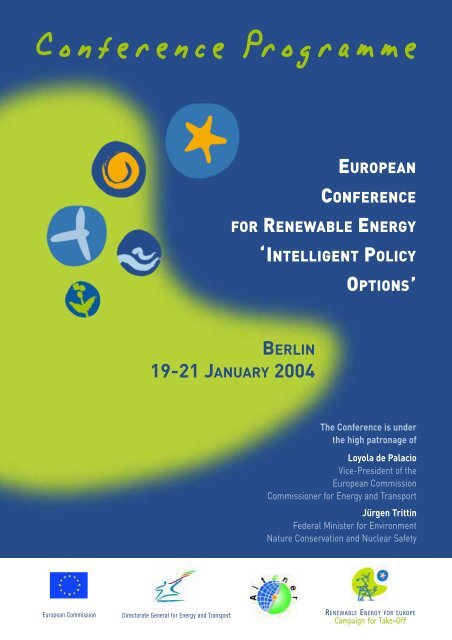
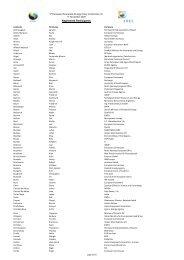
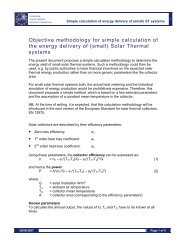
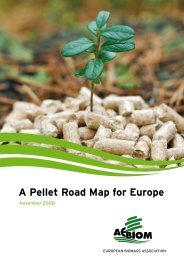
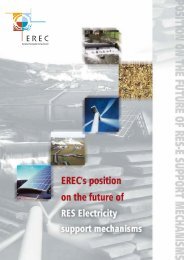
![Energy [R]evolution - Greenpeace](https://img.yumpu.com/47174859/1/184x260/energy-revolution-greenpeace.jpg?quality=85)
